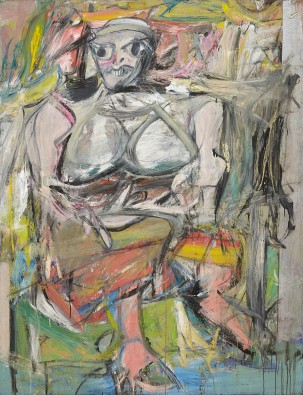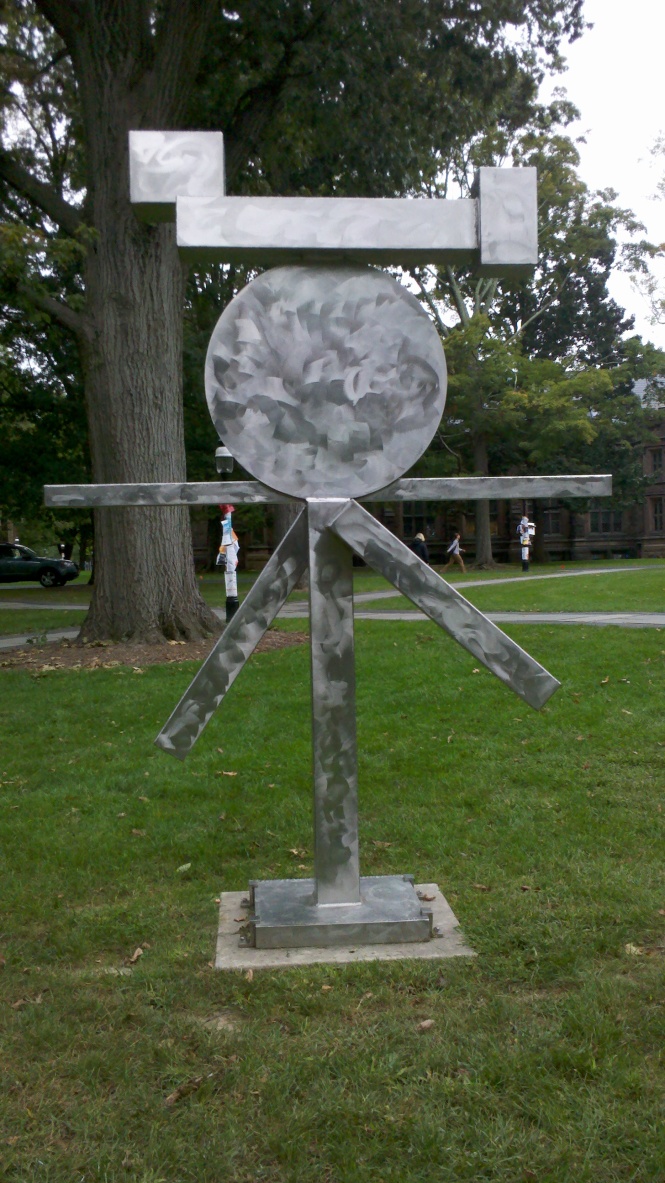After Wwii the Center of the Art World Moved to

Willem de Kooning,Woman I, 1950-52 (photo https://www.moma.org/wp/moma_learning/wp-content/uploads/2013/03/478_1953_CCCR-303×395.jpgv)
Later World War II, the focus of much of the art globe shifted to New York City. This was in no small-scale function because of the motion, either permanent or temporary, of so many European artists to New York during the war. These advanced artists shifted discussion of what constituted art in America, and touched off Abstruse Expressionism, amidst other movements.
Abstract Expressionism, which is mainly a motion of painters, is characterized by a f ocus on abstraction equally a means to express personal feelings and emotions. It is important to view these works equally a ways to express inner thoughts and emotions, equally opposed to simply a rejection of the naturalistic mode of many previous American art movements, such as the Ashcan School. This movement has oftentimes been misinterpreted, especially by critics such asCloudless Greenberg and the Formalists, who discussed this movement as the embodiment of the thought of "pure" art in abstraction because of the focus on formal elements. Greenberg, Clive Bell, and the other Formalists often ignored the statements of the Abstract Expressionist artists, who discussed their work in terms of emotions and spirituality, every bit much every bit abstraction and the formal elements. This move is very much the successor to the European Expressionist movements, which besides emphasized motility and colour every bit a means to express larger ideas, emotions, and concepts within the works themselves. This movement, though, is not without its issues, as the role of the men that identified with information technology, both in the 194os and 1950s and at present, tends to be emphasized over that of the women. Just, many influential female Abstract Expressionist artists were working at this time too, including Lee Krasner, Joan Mitchell, and Helen Frankenthaler. Frankenthaler is oftentimes credited with creating the technique of color field painting.
Action painting: Jackson Pollock, No 1 1950 (Lavender Mist), 1950 and Franz Kline, Untitled, c. 1950 (photo https://uploads1.wikiart.org/number-1-lavender-mist(1).jpg and By Nyuifa (Own work) [CC Past-SA 4.0 (http://creativecommons.org/licenses/by-sa/iv.0)%5D, via Wikimedia Commons)
In that location are 2 main divisions of painting in the Abstruse Expressionist style: Activeness painting and Colour Field painting. Action painting is characterized by the use of gestural abstraction when applying the paint to the canvas, and frequently uses more simplified colors. The virtually famous of the action painters is Jackson Pollock, known for his drip paintings, where he would lay the canvass on the ground, and utilise paint in thick layers using choreographed gestures.
Color Field Paintings: Helen Frankenthaler, Mountains and Ocean, 1952 and Barnett Newman, Vir Heroicus Sublimis, 1950-51 (photo https://upload.wikimedia.org/wikipedia/en/8/88/Frankenthaler_Helen_Mountains_and_Sea_1952.jpg and https://www.moma.org/wp/moma_learning/wp-content/uploads/2012/07/Barnett-Newman.-Vir-Heroicus-Sublimis1-469×208.jpg)
Color Field Painting tin can be seen as the "Simple expression of circuitous thought." Here, the paint is thinned out with linseed oil, water, or some other solvent, and practical thinly to the sail, often with the painter moving the canvas around to attain the forms created by the colors of the paints, such as with Frankenthaler'south piece of work or the paintings of Morris Louis. Another blazon of color field painting involves putting big flat areas of color on the sail, equally with Mark Rothko'due south and Barnett Newman's paintings, breaking them only with large or small areas of other colors. Hither, every bit with other colour field paintings, it is the colors used that are meaning to the understanding of the works.

David Smith,Cubi Thirteen, 1963 (photo By Undead q – Ain work, Public Domain, https://commons.wikimedia.org/w/alphabetize.php?curid=19577530)
American sculpture in the mail-war period is characterized past experimentation with form and textile, and the artists often incorporated industrial product methods and techniques. David Smith's Cubi series is one example of this, as these sculptures are made from brushed stainless steel in a foundry, and reflect some of the aforementioned ideas and concepts of the Abstract Expressionist painters.


OLYMPUS DIGITAL Photographic camera
Alexander Calder, The Clouds, 1954, Fundamental Academy of Venezuela and Le Halebardier, 1971, Hannover (photo Past Caracas1830 – Own work, CC Past 3.0, https://commons.wikimedia.org/w/index.php?curid=4422257 and Past Jim Champion from Southampton, UK – Modern art, CC BY-SA 2.0, https://commons.wikimedia.org/westward/index.php?curid=3703375)
Alexander Calder, in Paris in the early on 20th century began to experiment with art and movement, making mobiles, hanging sculptures set in motion by air currents. These eventually gave manner to his Stabiles, which were larger, more stable structures, assembled from steel and atomic number 26. These are Dadaist and Surrealist in their playful quality and influence of adventure, but more nonfigurative. His stabiles are oftentimes besides site-specific, made for one particular location.
Louise Bourgeois, Quarantania I, 1947-53 and Joseph Cornell, Suzy'south Sunday (for Judy Tyler), 1957 (photo https://www.moma.org/images/dynamic_content/exhibition_page/42776.jpg and http://artnc.org/sites/default/files/Cornell%2C%20Suzy%27s%20Sun%xx(for%20Judy%20Tyler)%2C%2078_1_1.jpg)
Other post-state of war sculptors in America began to experiment with biomorphic sculpture, using forms and materials that resembled the organic to create their abstract works. These often engaged in a dialogue with the viewer about the nature of bodies. All the same others began to employ a ssemblage as a means of creating their art work, incorporating found objects and other materials into works that played with some of the same ideas as the Dadaists and Surrealists: word play, chance, improvisation, and the often rigid definitions of the give-and-take "art."
Robert Capa, Normandy Invasion, June half-dozen, 1944 and Harry Callahan, Weed Confronting the Heaven, Detroit, 1948 (photograph http://media.vanityfair.com/photos/54cad29751062027082043cd/master/w_768,c_limit/image.jpg and http://www.christies.com/lotfinderimages/D56001/harry_callahan_weed_against_sky_detroit_1948_d5600196g.jpg)
American photographers of the period influenced by state of war and the Smashing Low. Many had photographed the War for a number of the news agencies and the Bang-up Depression for the Works Progress Administration, although not all had photographed both events. Many photographers were influenced by abstraction, and used their works as a means to abstract natural forms, moving abroad from a focus on the photograph as a document.
Alberto Giacometti, The Chariot, 1950 and Jean DuBuffet, Corps de Dame (Château d'Étoupe), 1950 (photo http://www.moma.org/collection_images/resized/788/app_zoom/CRI_246788.jpg and http://imgc.artprintimages.com/img/impress/print/jean-dubuffet-body-of-a-woman_a-g-10566904-8880731.jpg?w=671&h=894 )
Post-state of war European fine art was more directly in dialogue with the experience and aftermath of war. Much of Europe was left in ruins subsequently the war, and everyone in that location was reeling from the stupor of 2 Earth Wars in quick succession. Alberto Giacometti, who was friends with Sartre and the Existentialists, explored the paradoxical ability of emaciated human forms, and the idea of extinction in his works, oftentimes creating pieces that showed the human form as fragile and alone. Jean Dubuffet's work used the savage power of expression to highlight the ferocity of the modernistic earth. His work seems rooted in many of the same ideas equally the frottage pieces of Max Ernst, which too came out of a sense of chaos and the Surrealist ideas of automatism.
Francis Bacon, Painting, 1946 and Lucien Freud, Girl with a White Dog, 1951-52 (photo https://upload.wikimedia.org/wikipedia/en/4/44/Painting_1946.jpg and https://www.wsws.org/en/media/photos/legacy/2011aug/a02-freu-girl-480.jpg)

Henry Moore,Three Piece Reclining Figure No. 1, 1961, Yorkshire (photo CC BY-SA 2.0, https://commons.wikimedia.org/w/index.php?curid=248756)
Painting and Sculpture in Uk highlighted the importance of the figure. But here too this took many different forms. Francis Salary's works are often agonizing, equating human forms with sides of beef, and deconstructing the figure. These tin exist read as examinations of the violence and trauma of mod life, and were influenced by biomorphic surrealism. Lucian Freud, on the other hand, has created portraits that reflect his devotion to the concrete presence. Henry Moore was drawn to massive, biomorphic forms. Many of this large scale sculptures employ the traditional motif of reclining figure and a "mother earth" theme, but it is easy to read into them Moore's experience drawing the huddled masses in the tube stations of London as they were sheltering from German language bombs during Earth War Ii.
Werner Bischof, Cologne, 1946 and Robert Doisneau, From the series The Sideways Glance, 1949 (photo http://mediastore2.magnumphotos.com/CoreXDoc/MAG/Media/Home5/2/three/5/d/PAR133165.jpg and http://www.staleywise.com/drove/doisneau/doisneau_1_b.jpg)
Photographers in Europe were interested in both the sense of fragility of the era and the applesauce of modern life. Many of them documented the rebuilding of Europe subsequently the war, as well as the division of the continent into Due east and Westward as the Cold War began.
This catamenia can be seen as the stepping stone between the experiments of the modernists before and between the wars, and the slow move into Postmodernism by the 1970s.
Source: https://joannecarrubba.wordpress.com/2017/03/22/abstract-expressionism-and-art-after-world-war-ii/
0 Response to "After Wwii the Center of the Art World Moved to"
Post a Comment